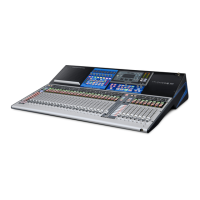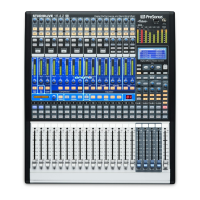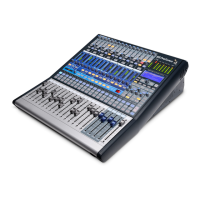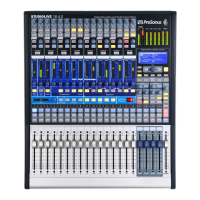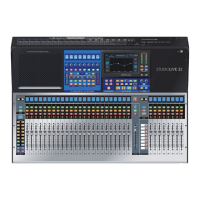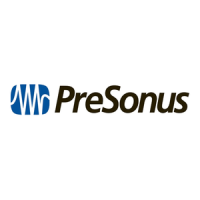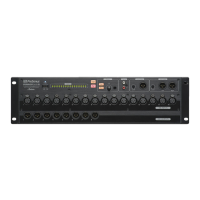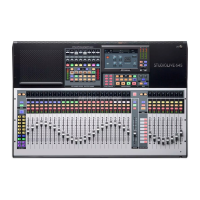Do you have a question about the PRESONUS StudioLive 16.0.2 USB and is the answer not in the manual?
Provides a general introduction to the StudioLive 16.0.2 USB mixer and its capabilities.
Explains the manual's content, including hardware functions and Power User Tips.
Lists the key hardware specifications and features of the StudioLive 16.0.2 USB mixer.
Details the items included in the StudioLive 16.0.2 USB package.
Information on accessing software, drivers, and manuals via the My PreSonus account.
Step-by-step guide for setting input levels and making initial connections for optimal audio.
Details the various input and output connectors on the mixer's rear panel.
Illustrates a common connection setup for a live band.
Shows a typical connection layout for a business conference setup.
Explains the function of the Select buttons for accessing Fat Channel parameters.
Describes controls like Trim, Polarity Invert, 48V, Pan, and Stereo Link.
Overview of the Fat Channel's dynamics processors and EQ section.
Details the High Pass Filter, its controls, and function.
Explains the Gate (downward expander) functionality and its controls.
Describes the Compressor and Limiter functions and their parameters.
Details the 3-band semi-parametric equalizer and its controls.
Explains the Dig Out function for sending processed or unprocessed audio.
How to copy, paste, and load Fat Channel settings and presets.
Instructions for loading pre-designed Fat Channel presets.
Guide on saving custom Fat Channel settings to the preset library.
Lists the available factory Fat Channel presets and storage locations.
Information on the mixer's metering capabilities and controls.
Details the buttons for selecting input, output, gain reduction, and fader locate metering.
Covers fundamental controls for each input channel.
Explains the setup and use of auxiliary and internal effects buses.
Details the controls for the analog auxiliary buses.
Describes master bus controls for the internal FXA and FXB processors.
How to create aux mixes and view send levels for each channel.
Guide on setting up custom monitor mixes for performers.
Steps for routing channels to internal FX processors.
Explains the MultiMode buttons for Solo, Mute, and USB Return functions.
Details how to route computer playback streams to mixer channels.
Describes how MultiMode buttons function as Solo buttons.
Explains how MultiMode buttons function as Mute buttons.
Controls and functions related to the main stereo output bus.
Information on the talkback microphone input and its routing.
Details the independent Solo bus for monitoring and setup.
Guidance on using the Solo bus for monitoring mixes with speakers or headphones.
Procedure for using SIP mode to dial in channel and overall mix settings.
Explains how to monitor multiple sources like main outputs, solo bus, and USB returns.
Accessing and adjusting the mixer's internal effects processors.
Steps for creating custom reverb and delay presets.
Details the parameters available for the reverb effects.
Explains the parameters for the different delay effect types.
Lists the available factory and user-created effects presets.
Overview of the 13 different effect types available on the mixer.
Information on creating, saving, and recalling mixer scenes.
Procedure for resetting all mixer parameters to their default settings.
Steps for saving the current mixer settings as a scene.
How to load previously saved scenes to restore mixer settings.
Functionality to display stored fader positions after scene recall.
How the mixer automatically saves current settings to internal memory.
Details the 31-band graphic EQ for the main output bus.
How to access and use the graphic EQ settings.
Instructions for saving and recalling graphic EQ settings.
Accessing and navigating the mixer's system settings.
Adjusting display settings for optimal viewing.
Configuring the pre/post fader send position for aux buses.
Enabling and configuring MIDI control for remote operation.
Enabling a password to lock mixer controls, preventing unauthorized changes.
Displays the current firmware version of the StudioLive mixer.
Detailed guide on controlling the mixer via MIDI devices or DAWs.
Explains fundamental MIDI terms relevant to mixer control.
Using Program Change messages for remote scene and FX preset recall.
Controlling mixer parameters like volume and FX assignment via CC messages.
Tutorial for configuring the Behringer FCB1010 to control the StudioLive.
Guide to configuring FCB1010 pedals for different MIDI channels.
Creating presets on the FCB1010 for controlling StudioLive functions.
Tutorial for configuring the Roland FC-300 to control the StudioLive.
Initial StudioLive setup required for MIDI footpedal control.
Steps to create a new patch on the FC-300 for controlling the StudioLive.
Instructions for naming and saving a new patch on the FC-300.
Provides guidance and examples for stereo microphone techniques.
Lists frequency ranges and their effects for EQ adjustments on various instruments.
Detailed technical specifications for the StudioLive 16.0.2 USB mixer.
A visual representation of the mixer's internal signal flow and connections.
A template for recording track settings, mic usage, and production notes.
Addresses common issues like no output, fader problems, and effects issues.
Details the warranty terms, coverage, exclusions, and how to obtain service.
Provides a general introduction to the StudioLive 16.0.2 USB mixer and its capabilities.
Explains the manual's content, including hardware functions and Power User Tips.
Lists the key hardware specifications and features of the StudioLive 16.0.2 USB mixer.
Details the items included in the StudioLive 16.0.2 USB package.
Information on accessing software, drivers, and manuals via the My PreSonus account.
Step-by-step guide for setting input levels and making initial connections for optimal audio.
Details the various input and output connectors on the mixer's rear panel.
Illustrates a common connection setup for a live band.
Shows a typical connection layout for a business conference setup.
Explains the function of the Select buttons for accessing Fat Channel parameters.
Describes controls like Trim, Polarity Invert, 48V, Pan, and Stereo Link.
Overview of the Fat Channel's dynamics processors and EQ section.
Details the High Pass Filter, its controls, and function.
Explains the Gate (downward expander) functionality and its controls.
Describes the Compressor and Limiter functions and their parameters.
Details the 3-band semi-parametric equalizer and its controls.
Explains the Dig Out function for sending processed or unprocessed audio.
How to copy, paste, and load Fat Channel settings and presets.
Instructions for loading pre-designed Fat Channel presets.
Guide on saving custom Fat Channel settings to the preset library.
Lists the available factory Fat Channel presets and storage locations.
Information on the mixer's metering capabilities and controls.
Details the buttons for selecting input, output, gain reduction, and fader locate metering.
Covers fundamental controls for each input channel.
Explains the setup and use of auxiliary and internal effects buses.
Details the controls for the analog auxiliary buses.
Describes master bus controls for the internal FXA and FXB processors.
How to create aux mixes and view send levels for each channel.
Guide on setting up custom monitor mixes for performers.
Steps for routing channels to internal FX processors.
Explains the MultiMode buttons for Solo, Mute, and USB Return functions.
Details how to route computer playback streams to mixer channels.
Describes how MultiMode buttons function as Solo buttons.
Explains how MultiMode buttons function as Mute buttons.
Controls and functions related to the main stereo output bus.
Information on the talkback microphone input and its routing.
Details the independent Solo bus for monitoring and setup.
Guidance on using the Solo bus for monitoring mixes with speakers or headphones.
Procedure for using SIP mode to dial in channel and overall mix settings.
Explains how to monitor multiple sources like main outputs, solo bus, and USB returns.
Accessing and adjusting the mixer's internal effects processors.
Steps for creating custom reverb and delay presets.
Details the parameters available for the reverb effects.
Explains the parameters for the different delay effect types.
Lists the available factory and user-created effects presets.
Overview of the 13 different effect types available on the mixer.
Information on creating, saving, and recalling mixer scenes.
Procedure for resetting all mixer parameters to their default settings.
Steps for saving the current mixer settings as a scene.
How to load previously saved scenes to restore mixer settings.
Functionality to display stored fader positions after scene recall.
How the mixer automatically saves current settings to internal memory.
Details the 31-band graphic EQ for the main output bus.
How to access and use the graphic EQ settings.
Instructions for saving and recalling graphic EQ settings.
Accessing and navigating the mixer's system settings.
Adjusting display settings for optimal viewing.
Configuring the pre/post fader send position for aux buses.
Enabling and configuring MIDI control for remote operation.
Enabling a password to lock mixer controls, preventing unauthorized changes.
Displays the current firmware version of the StudioLive mixer.
Detailed guide on controlling the mixer via MIDI devices or DAWs.
Explains fundamental MIDI terms relevant to mixer control.
Using Program Change messages for remote scene and FX preset recall.
Controlling mixer parameters like volume and FX assignment via CC messages.
Tutorial for configuring the Behringer FCB1010 to control the StudioLive.
Guide to configuring FCB1010 pedals for different MIDI channels.
Creating presets on the FCB1010 for controlling StudioLive functions.
Tutorial for configuring the Roland FC-300 to control the StudioLive.
Initial StudioLive setup required for MIDI footpedal control.
Steps to create a new patch on the FC-300 for controlling the StudioLive.
Instructions for naming and saving a new patch on the FC-300.
Provides guidance and examples for stereo microphone techniques.
Lists frequency ranges and their effects for EQ adjustments on various instruments.
Detailed technical specifications for the StudioLive 16.0.2 USB mixer.
A visual representation of the mixer's internal signal flow and connections.
A template for recording track settings, mic usage, and production notes.
Addresses common issues like no output, fader problems, and effects issues.
Details the warranty terms, coverage, exclusions, and how to obtain service.
| Frequency range | 20 - 20000 Hz |
|---|---|
| Channels quantity | 16 channels |
| Supported sample rates | 44.1, 48 kHz |
| Digital sound processing | 32 bit |
| Nominal input level | 22 dBu |
| Output impedance | 100000 Ω |
| Total Harmonic Distortion (THD) | 0.005 % |
| AUX out ports | 4 |
| USB 2.0 ports quantity | 1 |
| Number of microphone inputs | 12 |
| AC input voltage | 100 - 240 V |
| AC input frequency | 50 - 60 Hz |
| DJ mixer | - |
| Product color | Black |
| Video capability | No |
| USB connector type | USB Type-B |
| Depth | 397 mm |
|---|---|
| Width | 406 mm |
| Height | 140 mm |
| Weight | 7300 g |

